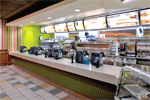 Fifty McDonald’s restaurants across the country are now saving 50% on power bills for kitchen extractor fans with the help of ABB Inverter drives.
Fifty McDonald’s restaurants across the country are now saving 50% on power bills for kitchen extractor fans with the help of ABB Inverter drives.
Dave Holden, Project Manager, Restaurant Services, for McDonalds, says: “We were updating old equipment and realised we could reduce our carbon footprint by making large fans run more slowly.
“Variable speed control was implemented on fan units with large 5.5kW motors. These now draw about 2kW for most of the time, but have the capacity to boost extract volumes significantly at busy times.
“Variable speed control gives us the extraction volumes we need while cutting energy use. We will also change our specifications to request variable speed control when new equipment is purchased.”
Although Holden had no particular product in mind, he did want a branded drive that had been proven reliable: “Reliability coupled with a fit-and-forget setup was essential. Our managers work incredibly hard running successful restaurants and do not want to be troubled with technical equipment unnecessarily.”
ABB Drives Alliance member, Inverter Drive Systems (IDS) in Nottingham has been working with McDonalds for six years and is included in McDonalds’ handbook of recommended suppliers. Holden has a particular set of requirements for his drives supplier: “We want flexibility, a ‘can-do’ attitude and trust. Inverter Drive Systems have proven reliable in all of these areas.”
McDonalds was hoping to see 40% energy savings and less wear and tear on the fan, including soft start-up. IDS were asked to look at the application and come up with the correct drive.
IDS’ solution was 5.5kW ABB HVAC drives. Blaise Ford of IDS says: “Using the drive’s real-time clock, we made the fans run at full speed over the busy periods and at 80% speed at other times. This resulted in a 50% saving in energy. On some installations, a boost button allows the fan to speed up to its full extraction speed if needed. Another major benefit was the reduced fan noise that this drive method allowed, particularly important to McDonalds at night.”
Variable speed control also cured a problem which was affecting the operation of cooking equipment in the kitchen. In order to contain cooking smells within the kitchen area, McDonalds aim to supply 85% of the air it extracts through air conditioning plant. High extraction rates were creating an imbalance that meant whenever an external door or window was opened, there was a rush of cold air into the kitchen, affecting the energy consumption of the equipment as it attempted to maintain its cooking temperature. It also meant the air conditioning was working harder to maintain a comfortable temperature. Reducing the fan speed has alleviated these problems.
Holden says: “The average 50% saving in electrical consumption across the restaurants was even greater in select locations that had oversized fan motors from the 1980’s. As well as reduced utilities costs, we now have fewer operational difficulties with the kitchen equipment as a result of being able to balance the extract volume.”
